Shamrock Foods Bundle
Unveiling the Owners: Who Really Controls Shamrock Foods?
Understanding the ownership of a company is crucial for grasping its strategic direction and potential for growth. Shamrock Foods, a major player in the foodservice industry, operates with a unique structure, setting it apart from its publicly traded rivals. Knowing Shamrock Foods SWOT Analysis can also help you understand the company better.
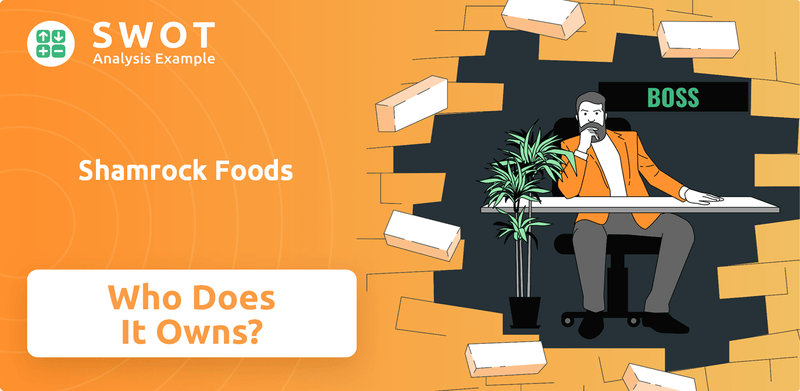
This exploration into "Who owns Shamrock Foods" will uncover the evolution of its ownership, starting from its roots as a dairy operation founded by W.R. McClelland. We'll delve into the current stakeholders, including family involvement, and analyze how its private status impacts governance and strategic choices. Discover how Shamrock Foods' ownership structure influences its position in the competitive foodservice and dairy markets, offering insights into its resilience and future prospects.
Who Founded Shamrock Foods?
The story of Shamrock Foods began in 1922, thanks to W.R. McClelland. He started the company with a clear vision: to deliver quality dairy products. Because the company is privately held, the initial ownership details, like how the shares were split up, aren't available for public view.
From its start in Tucson, Arizona, with just one truck, the company grew. Early on, the McClelland family held most of the ownership. This family-focused approach was common for businesses that started in the early 20th century. There's no public information about early investors or outside funding during those initial stages, which suggests the business was self-funded or supported by the family.
As a private entity, the company doesn't disclose details about early agreements. However, the fact that the McClelland family has continued to lead the company through generations shows their dedication to maintaining family control. There are no public records of ownership disputes or buyouts in the beginning, indicating a cohesive family structure from the start.
The early ownership of Shamrock Foods was centered within the McClelland family, reflecting a common pattern among businesses founded in the early 1900s. The company's beginnings were modest, starting with a single truck and a focus on dairy products, which laid the groundwork for its future expansion. The absence of publicly documented early investors or disputes highlights the family's commitment to maintaining control and upholding the founding vision.
- Founder: W.R. McClelland established Shamrock Foods in 1922.
- Ownership: Primarily held by the McClelland family from the outset.
- Funding: Likely self-funded or family-financed, with no public records of external investors.
- Focus: Initially focused on dairy products, expanding later to a broader foodservice distribution.
- Structure: Maintained a private, family-owned structure, which continues to this day.
Shamrock Foods SWOT Analysis
- Complete SWOT Breakdown
- Fully Customizable
- Editable in Excel & Word
- Professional Formatting
- Investor-Ready Format
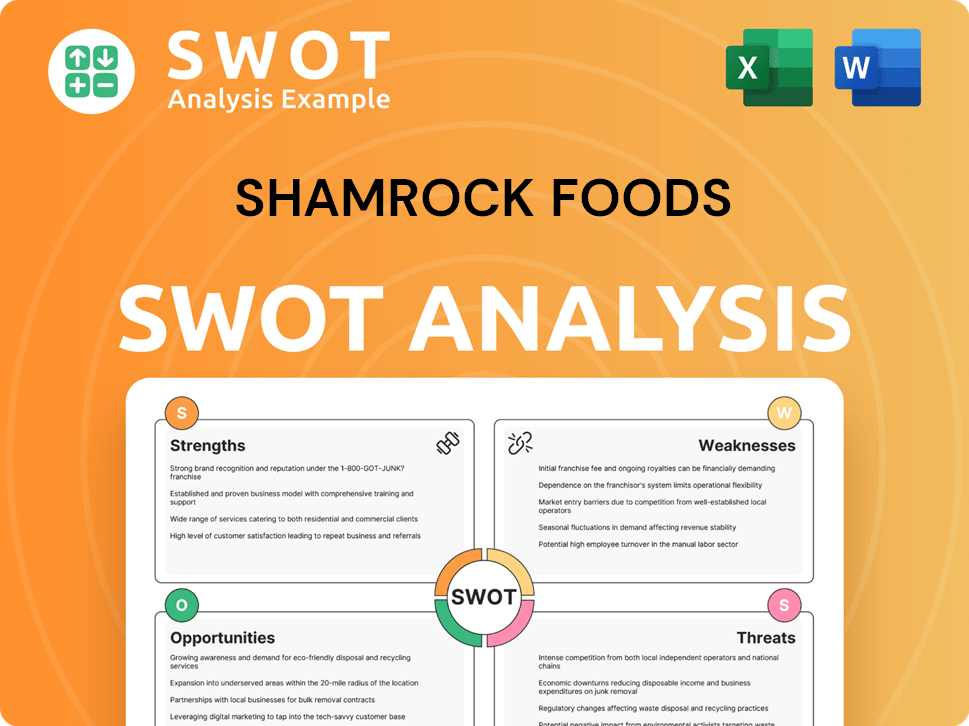
How Has Shamrock Foods’s Ownership Changed Over Time?
Since its establishment in 1922, Shamrock Foods has remained a privately held, family-owned business. This structure has significantly shaped its ownership evolution. The company has not undergone an initial public offering (IPO), and its shares are not publicly traded. This means there are no shifts in major shareholding among institutional investors or mutual funds. The ownership has primarily been maintained within the McClelland family across multiple generations. This family ownership is a key differentiator in the foodservice and dairy industries.
As a private entity, specific details on investment rounds or changes in equity allocation are not publicly disclosed. However, the company's sustained growth and expansion, including the acquisition of Valley Produce in 2024, indicate strategic financial management and investment. These investments are likely through retained earnings, debt financing, or private capital within the family. The major stakeholders are members of the McClelland family, who continue to hold leadership positions and control the company's strategic direction. This long-standing family ownership allows Shamrock Foods to prioritize long-term growth and stability over short-term financial pressures.
| Aspect | Details | Impact |
|---|---|---|
| Ownership Structure | Privately held, family-owned since 1922 | Ensures long-term vision and stability, free from public shareholder pressures. |
| Public Trading | Not publicly traded; no IPO | No influence from external shareholders, allowing for strategic decisions focused on family values. |
| Key Stakeholders | McClelland family | Maintains control over strategic direction and company vision. |
The absence of external public shareholders means decisions, such as expanding product lines or making capital investments, are made with a focus on the family's long-term vision. This approach has allowed Shamrock Foods to navigate market changes and maintain a strong position in the industry. The company's focus on its core values and long-term sustainability has been a key factor in its continued success.
Shamrock Foods' ownership structure is centered on family control and private operations.
- Family ownership ensures a focus on long-term growth and stability.
- The company's private status allows for strategic decisions without external shareholder influence.
- The McClelland family continues to be the primary stakeholder, guiding the company's vision.
- Shamrock Foods' private structure is a key differentiator in its industry.
Shamrock Foods PESTLE Analysis
- Covers All 6 PESTLE Categories
- No Research Needed – Save Hours of Work
- Built by Experts, Trusted by Consultants
- Instant Download, Ready to Use
- 100% Editable, Fully Customizable
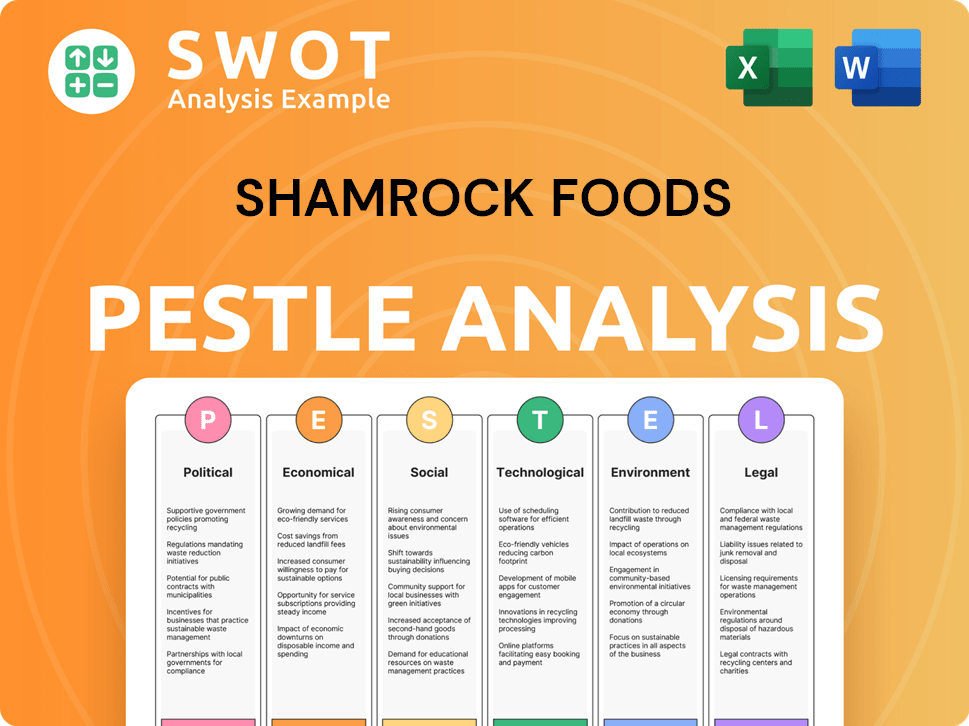
Who Sits on Shamrock Foods’s Board?
As a privately held entity, the specifics concerning the Board of Directors for the Shamrock Foods company are not publicly available in the same way as for publicly traded corporations. The board is mainly composed of members of the McClelland family, who are the major shareholders. It is likely that some independent directors or long-standing executives are also on the board. These individuals offer external expertise and operational insights. The presence of family members on the board ensures that the ownership's vision and long-term interests are directly represented in the company's governance and strategic decision-making.
The Board of Directors plays a crucial role in guiding the company's strategic direction and ensuring its ongoing success. Their responsibilities include overseeing the company's financial performance, approving major investments, and setting the overall business strategy. The board also ensures that the company adheres to its values and maintains a strong ethical foundation. Given the private nature of Shamrock Foods, the board's focus is on long-term value creation and sustainable growth, with a unified vision driven by family ownership.
| Board Member | Role | Notes |
|---|---|---|
| Family Members | Directors | Represent major shareholders, ensuring family vision. |
| Independent Directors | Directors | Provide external expertise and operational insights. |
| Long-standing Executives | Directors | Offer operational knowledge and company history. |
Given its private ownership, the voting structure is most likely concentrated within the McClelland family. The voting structure probably follows a one-share-one-vote principle among family shareholders. There are no public records of dual-class shares or special voting rights, as these are typically associated with public companies. Decision-making within the company is streamlined by the unified vision of its family ownership. This allows for agility in responding to market changes and pursuing long-term strategic goals. For more insights into the company's operations, consider reading about the Revenue Streams & Business Model of Shamrock Foods.
Shamrock Foods' Board of Directors is primarily composed of the McClelland family, ensuring family control and long-term vision.
- The voting structure is likely concentrated within the McClelland family, maintaining control.
- The board focuses on long-term value creation and sustainable growth.
- Decision-making is streamlined due to unified family ownership.
- The company's private status allows for agility in responding to market changes.
Shamrock Foods Business Model Canvas
- Complete 9-Block Business Model Canvas
- Effortlessly Communicate Your Business Strategy
- Investor-Ready BMC Format
- 100% Editable and Customizable
- Clear and Structured Layout
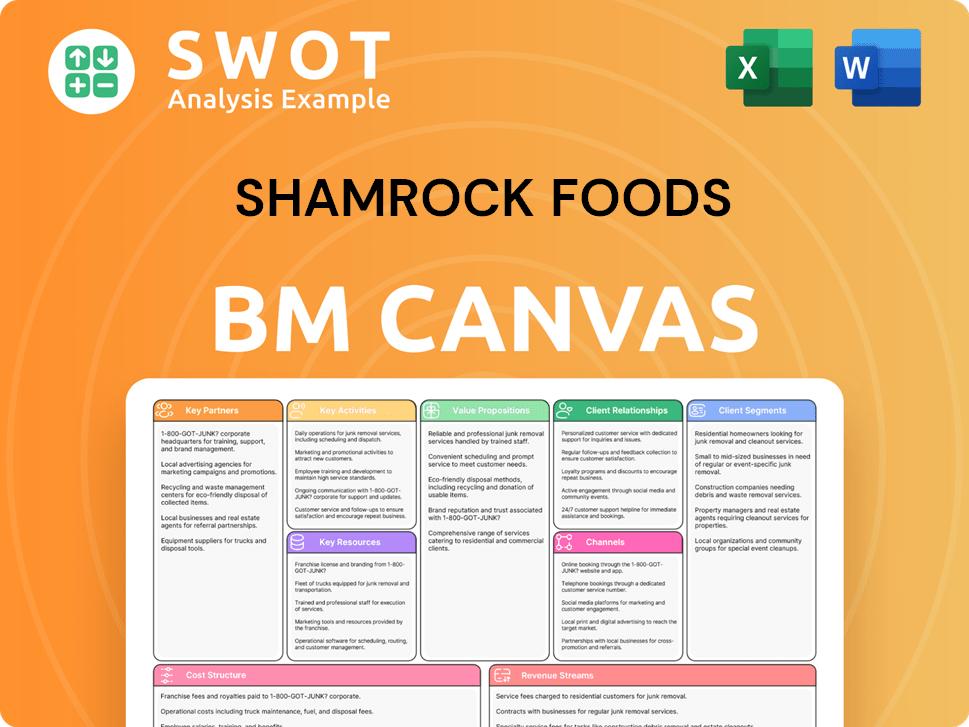
What Recent Changes Have Shaped Shamrock Foods’s Ownership Landscape?
Over the past few years, Shamrock Foods has maintained its privately held status, focusing on strategic growth and operational expansions. As a privately owned entity, specific details about ownership changes, such as share buybacks, are not publicly disclosed. However, the company has demonstrated its commitment to growth through significant acquisitions and investments within its operational framework. A notable development in 2024 was the acquisition of Valley Produce, which broadened Shamrock Foods' reach and product offerings, particularly in the fresh produce sector. This move highlights the company's ability to leverage its internal capital to seize growth opportunities without the constraints of public market dynamics.
The ownership structure of Shamrock Foods reflects trends common among privately held companies, including continued family involvement and strategic acquisitions. This approach allows the company to prioritize long-term value creation over short-term shareholder returns. There have been no public announcements regarding future ownership changes, succession plans, or potential public listings, reinforcing its commitment to remaining a privately held entity. This structure enables Shamrock Foods to maintain its unique corporate culture, invest in long-term initiatives, and adapt swiftly to market changes. The company's ongoing growth, as evidenced by its recent acquisitions and operational expansions, underlines the effectiveness of its stable, privately-owned structure in the competitive foodservice and dairy industries. The company’s focus remains on its core business, with no indication of altering its ownership model.
Industry analysts and market observers note that Shamrock Foods' private status allows for greater flexibility in strategic decision-making and investment. For example, the company's ability to fund acquisitions like Valley Produce without public market scrutiny provides a competitive advantage. This private ownership model also supports a culture that values long-term sustainability and customer relationships, which are crucial in the foodservice and distribution sectors. The company’s continued expansion and market presence underscore the success of its privately held structure, allowing it to navigate industry challenges effectively.
Shamrock Foods has expanded its operations through strategic acquisitions. The acquisition of Valley Produce in 2024 is a prime example. These acquisitions are funded through internal capital, a common strategy for privately held companies. This approach allows for controlled growth and market diversification.
Shamrock Foods' ownership structure remains stable, with no public announcements of changes. The company's commitment to remaining private allows for a focus on long-term value. This stability helps maintain the company’s unique culture and strategic vision.
Privately held companies often focus on family involvement and strategic acquisitions. These companies are less influenced by short-term market pressures. Shamrock Foods aligns with these trends, emphasizing long-term growth and market presence.
The private status of Shamrock Foods allows for quick decision-making and investment flexibility. This structure is beneficial in a competitive market. Shamrock Foods can adapt to market changes more efficiently than publicly traded companies.
Shamrock Foods Porter's Five Forces Analysis
- Covers All 5 Competitive Forces in Detail
- Structured for Consultants, Students, and Founders
- 100% Editable in Microsoft Word & Excel
- Instant Digital Download – Use Immediately
- Compatible with Mac & PC – Fully Unlocked
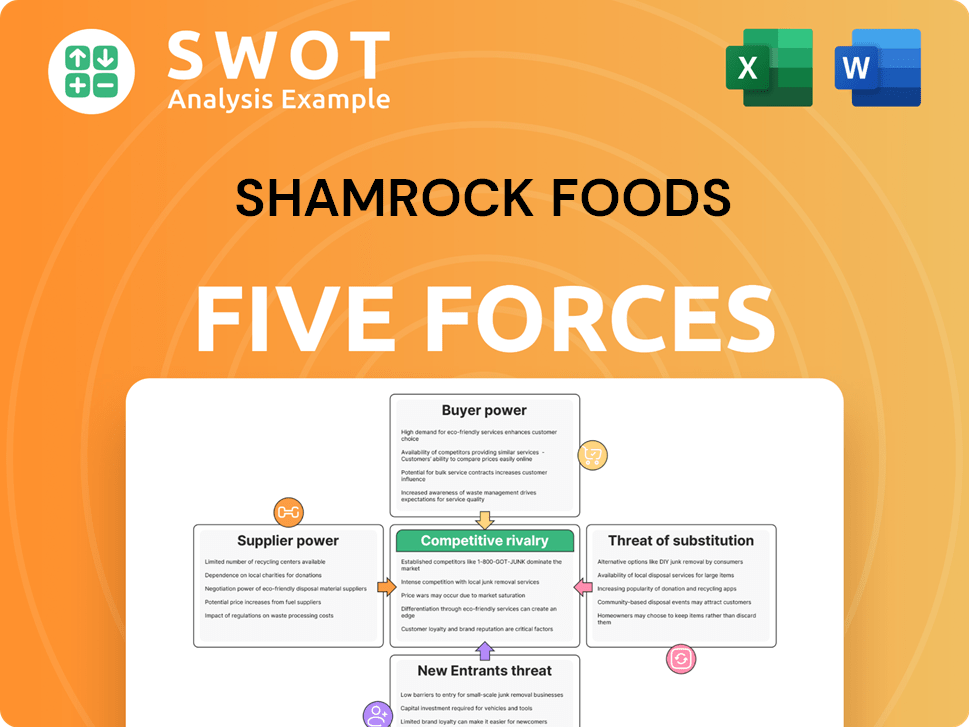
Related Blogs
- What are Mission Vision & Core Values of Shamrock Foods Company?
- What is Competitive Landscape of Shamrock Foods Company?
- What is Growth Strategy and Future Prospects of Shamrock Foods Company?
- How Does Shamrock Foods Company Work?
- What is Sales and Marketing Strategy of Shamrock Foods Company?
- What is Brief History of Shamrock Foods Company?
- What is Customer Demographics and Target Market of Shamrock Foods Company?
Disclaimer
All information, articles, and product details provided on this website are for general informational and educational purposes only. We do not claim any ownership over, nor do we intend to infringe upon, any trademarks, copyrights, logos, brand names, or other intellectual property mentioned or depicted on this site. Such intellectual property remains the property of its respective owners, and any references here are made solely for identification or informational purposes, without implying any affiliation, endorsement, or partnership.
We make no representations or warranties, express or implied, regarding the accuracy, completeness, or suitability of any content or products presented. Nothing on this website should be construed as legal, tax, investment, financial, medical, or other professional advice. In addition, no part of this site—including articles or product references—constitutes a solicitation, recommendation, endorsement, advertisement, or offer to buy or sell any securities, franchises, or other financial instruments, particularly in jurisdictions where such activity would be unlawful.
All content is of a general nature and may not address the specific circumstances of any individual or entity. It is not a substitute for professional advice or services. Any actions you take based on the information provided here are strictly at your own risk. You accept full responsibility for any decisions or outcomes arising from your use of this website and agree to release us from any liability in connection with your use of, or reliance upon, the content or products found herein.